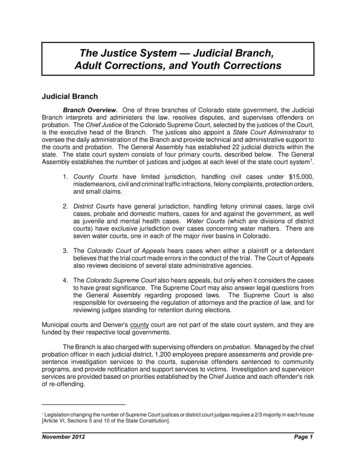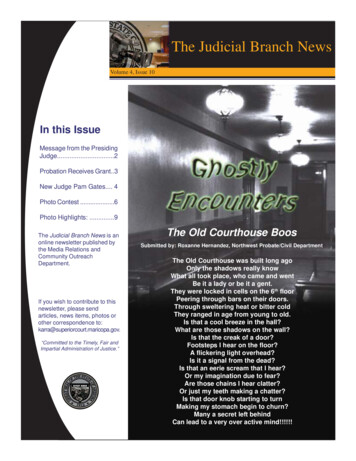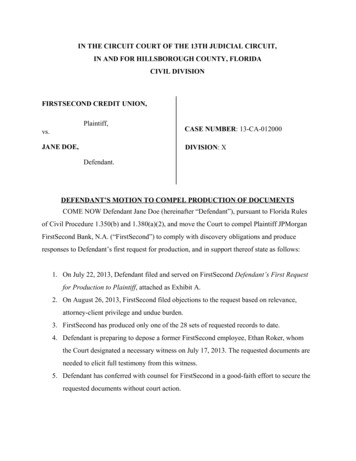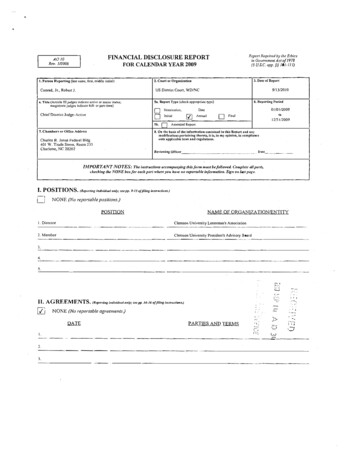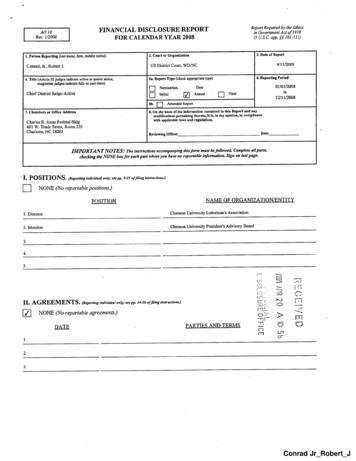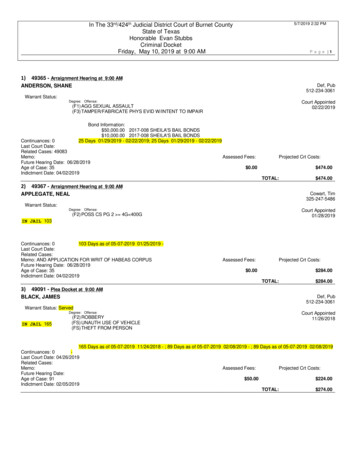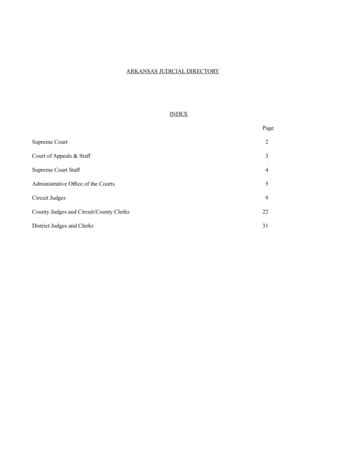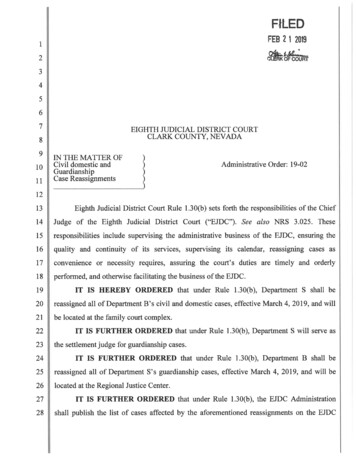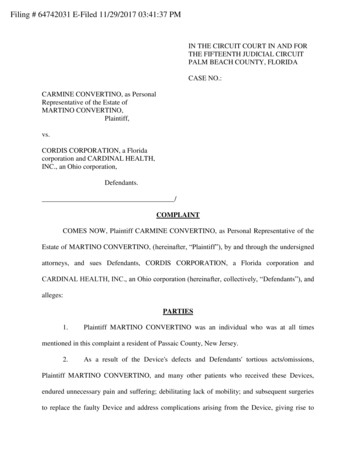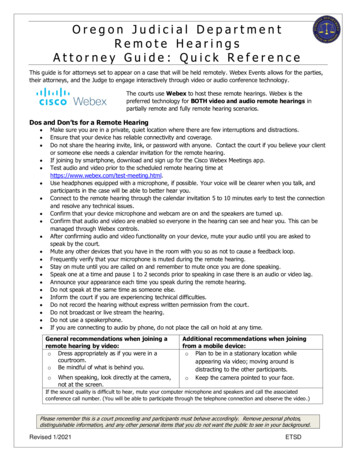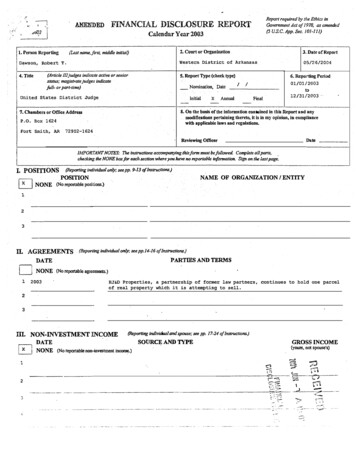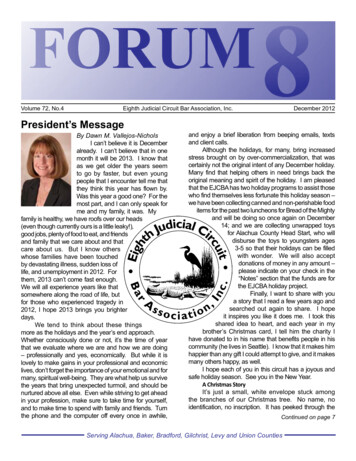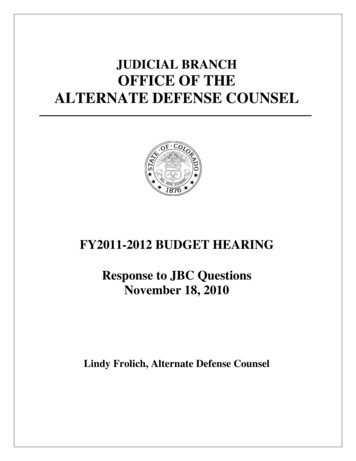
Transcription
JUDICIAL BRANCHOFFICE OF THEALTERNATE DEFENSE COUNSELFY2011-2012 BUDGET HEARINGResponse to JBC QuestionsNovember 18, 2010Lindy Frolich, Alternate Defense Counsel
QUESTIONS TO AGENCYINTRODUCTIONS AND OPENING COMMENTS1. Please describe how the OADC evaluates the effectiveness of its programs and services.The mandate of the OADC is to provide competent and effective legal representationto indigent defendants (adults and juveniles) in cases where the state public defenderhas an ethical conflict of interest. This representation must uphold the federal andstate constitutional and statutory mandates, ethical rules, and nationwide standards ofpractice for criminal defense lawyers. These legal services should be commensuratewith those services available to non-indigent defendants.To evaluate the effectiveness of the OADC mandate, the agency does the following:Recruits and contracts with private criminal defense lawyers; reviews and evaluatesattorney performance; conducts a monthly review of the number of cases paid, theaverage hours billed by attorneys, investigators and paralegals by case type; andcompares the agency’s budget to actual expenditures to date for all appropriated lineitems.Further, if the OADC is currently statutorily required to administer one or more programs thatare no longer effective or appropriate, please identify such programs and the associatedstatutory provisions. N/A2. Please identify the OADC’s three most effective programs or services and the three leasteffective programs, and explain why you identified them as such. How do your most effectiveprograms further the OADC’s goals? What recommendations would you make to increase theeffectiveness of the three least effective programs?The OADC is a single program agency, whose only service is to provide legalrepresentation to indigent defendants. To answer this question the OADC will addressthe three most effective and the three least effective measures that have beenimplemented in recent years.MOST EFFECTIVE MEASURESThe agency has identified its three most effective measures based on how they meetthe agency’s objectives of providing cost-effective and competent legal representationstatewide. A detailed description of the activities involved in these measures isincluded in the response to question number 3 below.November 18, 20102Judicial BranchOffice of the Alternate Defense Counsel
A. Attorney Evaluations: This measure meets the agency’s goals by insuringthat each OADC contractor is competent to provide legal representation toindigent defendants, in a cost-effective manner, and meets therequirements of OADC’s state performance audit of 2006.B. Appellate Project: This measure meets the agency’s goals by streamliningthe appellate process and insuring that the agency contracts with lawyerswho specialize in appeals, resulting in higher quality representation for areduced cost.C. Post-conviction Project: This measure meets the agency’s goals bystreamlining the post-conviction process, triaging cases prior to assignmentto a qualified post-conviction lawyer, and contracting the case for a flat fee.This process insures that post-conviction cases have qualified lawyers thatprovide representation cost-effectively.LEAST EFFECTIVE MEASURESThe agency has identified its three least effective measures based on how thesemeasures fail to meet the agency’s objectives of providing cost-effective andcompetent legal representation statewide. A detailed description of the activitiesinvolved in these measures is included in the response to question number 3 below.D. Attorney Hourly Rates: In 2005, because of the great disparity between thethen existing rate , and the suggested rate of a judicial department study of 75 per hour, the JBC recommended a five year implementation plan tosecure a rate of 75 per hour for court-appointed counsel. The OADC hasnot requested an hourly rate increase since FY2008-2009, due to the currentstate of the economy, and the state’s budget shortfall. To avoid any hourlyrate decrease, the OADC has implemented other savings such as notreimbursing attorney mileage, and closer scrutiny of expert, investigator andparalegal requests. The disparity between the private hourly rate and theCJA hourly rate of 125 and the OADC 65 hourly rate continues to deterextremely qualified attorneys from contracting with the OADC.E. Discovery Costs: The cost of discovery continues to rise every year. Theagency has no control over the rates charged by individual district attorney’soffices. As was requested by the JBC, the judicial branch, together with theColorado District Attorney’s Council, is working to create some uniformityby clarifying Crim. P. Rule 16, and providing additional information on howdiscovery rates are to be set. The OADC has implemented strategies in anattempt to offset some of the increases in the cost of discoverydissemination. This includes utilizing a contract computer specialist toNovember 18, 20103Judicial BranchOffice of the Alternate Defense Counsel
process discovery for OADC contractors. A pilot project is currently takingplace in Jefferson County to see if this is a more cost-effective and efficientmethod of distributing discovery to OADC contractors.F. Attorney Hours Per Case: Some case types are more labor intensive due tothe complexity of litigation. These include death penalty cases on both thetrial level and pursuant to the unitary appeal bill, actual innocence cases,habitual criminal cases, and Colorado Organized Crime Control Act (COCCA)cases. As a result, it is difficult to contain the number of attorney hours percase. If the number of death penalty cases, habitual filings and COCCA caseswere reduced, the agency anticipates that there would be an overallreduction in the number of attorney hours. Through our appellate and postconviction processes the agency has reduced the number of attorney hoursfor appellate and post-conviction cases.3.For the three most effective and the three least effective programs identified above, pleaseprovide the following information:a. A statement listing any other state, federal, or local agencies that administer similar orcooperating programs, and outline the interaction among such agencies for each program;The OADC is similar to the Office of the Public Defender in that we provide lawyersto represent indigent persons accused of crimes. OADC pays the lawyers for everyhour they work and reimburses them for allowed expenses. This differs from thePublic Defender system, where the lawyers, investigators, and paralegals are allsalaried state employees.We are also similar to the Office of Child'sRepresentative in terms of our contracting structure, although the services weprovide are different.The CJA (Criminal Justice Act) is the federal program similar to the OADC. The CJA isa panel of contract criminal defense attorneys that provides legal representation toindigent defendants in federal criminal cases where the federal public defender’soffice has an ethical conflict of interest. The major difference is that the OADClawyers are paid at a rate which averages 59 per hour less than then the CJAfederal rate of 125 per hour.b. A statement of the statutory authority for these programs and a description of the need forthese programs;The Office of the Alternate Defense Counsel (OADC) is mandated by statute to"provide to indigent persons accused of crimes, legal services that arecommensurate with those available to non-indigents, and conduct the office inNovember 18, 20104Judicial BranchOffice of the Alternate Defense Counsel
accordance with the Colorado Rules of Professional Conduct and with the AmericanBar Association Standards relating to the administration of criminal justice, thedefense function." C.R.S. § 21-2-101(1) (emphasis added).The right to counsel is guaranteed by the Colorado and the United StatesConstitutions. The Office of Alternate Defense Counsel contracts with privatecriminal defense lawyers who work in every judicial district at a designated staterate. There are two statutory requirements before an accused person can beappointed OADC counsel: First they must be indigent and second, the PublicDefender’s Office must have an ethical conflict of interest. The OADC attorneycontractors must uphold the federal and state constitutional and statutorymandates, ethical rules and nationwide standards of criminal defense practice.OADC contracts with over 400 private lawyers on a regular basis and has workedwith nearly 1,000 private lawyers over the past 10 years. In addition, OADC utilizesinvestigators and paralegals to provide necessary services required by lawyers toeffectively represent indigent clients.These private lawyers, on behalf of OADC, represent adults and children in criminaland delinquency cases filed in county, district, and appellate courts. The severity ofcase types range from lower class misdemeanors to capital murder cases where thepotential sentence is death. Lawyers who contract with OADC are trained incriminal defense work in general and many have specialty areas such as: ColoradoOrganized Crime Control Act (COCCA), delinquency cases, death penalty cases, sexassault cases, mental health issues, etc. All OADC lawyers, investigators, andparalegals are independent contractors and not state employees.Prior to the creation of the agency there was no standardized method of courtappointments. The court might appoint a lawyer who happened to be present incourt, there might be a list from which appointments were made, or theappointment might come from the clerk’s office. Payments for these appointmentswere administered by a division of the Colorado State Public Defender’s Office.c. A description of the activities which are intended to accomplish each objective of theprograms, as well as, quantified measures of effectiveness and efficiency of performanceof such activities; See response below in 3.) e.d. A ranking of the activities necessary to achieve the objectives of each program by priorityof the activities; See response below in 3.) e.ande. The level of effort required to accomplish each activity associated with these programs interms of funds and personnel.November 18, 20105Judicial BranchOffice of the Alternate Defense Counsel
Because subsections c., d., and e. are interrelated, the answers are combined intoone section for each of the measures identified above.A. Attorney EvaluationsPursuant to the state performance audit of 2006, the OADC began a process toinsure that all OADC lawyers and investigators are under a current contract. Thisprocess includes interviewing and evaluating all attorney contractors andcontracting with investigators. To accomplish this, the agency has developed 7basic components:1. Maintain a tracking system with all attorney and investigator vendors includingcontract renewal dates.2. Contact and request renewal applications from attorney contractors, interviewand evaluate contractor, and renew contract if appropriate.3. Receive feedback from judicial districts concerning OADC lawyers.4. Verify attorney status with the Office of Attorney Regulation.5. Monitor and evaluate lawyer court room practices.6. Request applications from current investigators and secure a current contract.Contact investigators regarding contract renewal and renew when appropriate.7. Conduct audit and time-efficiency studies of select OADC contract attorneys.The process of evaluating attorneys is ongoing. However, there is a 3-4 monthperiod each year that is more labor intensive and involves 4 separate FTE. Thisincludes an administrative assistant, the training/evaluation director, the directorand the deputy director.Performance MeasureInterview contract applicants;evaluate contractors prior tocontract renewal date, andongoing performancemonitoring. Contract withinvestigators.November 18, 09 100%99%99%50%50%100%100%50%25%6Judicial BranchOffice of the Alternate Defense Counsel
B. Appellate Project:In FY2006-2007, the OADC began a pilot project to see if the appellate process couldbe streamlined though the use of an in- house appellate paralegal. Following themodel used by the Colorado State Public Defender’s office for appellate cases, theOADC contracted with a paralegal to initiate this project. Since the program began,the number of appellate attorney hours per case has decreased. This pilot projecthas now become a permanent cost-saving measure for the agency. This projectinvolves the following components:1. All appellate cases are initiated by the appellate paralegal by interfacingwith all judicial district appellate clerks.2. The paralegal contacts and arranges with every judicial departmentmanaging court reporter to prepare and receive the record on appeal and;3. Insures deadlines are met by monitoring the appellate record andcertification thereof through management and coordination of activitiesbetween OADC lawyers, court reporters, clerks of court, public defender’sappellate division and the Colorado Court of Appeals and;4. Drafts and files pleadings for appeals and;5. Coordinates appellate assignments with the Court of Appeals and qualifiedOADC lawyer contractors.The appellate process is ongoing. It requires ½ FTE, as well as some input from thedirector and deputy director.FY06Appeal CasesAverage Hours per CaseOut-of-CourtIn-CourtParalegalInvestigatorOther TravelTotal Appeal HoursNovember 18, 43.3944.0341.037Judicial BranchOffice of the Alternate Defense Counsel
C.Post-Conviction Project:In FY09-10, based on the success of the appellate project, and the burgeoning costs ofpost-conviction cases, the OADC expanded its in-house paralegal’s responsibilities toinclude initial coordination of post-conviction cases. This project involves thefollowing components:1. The OADC paralegal responds to the notification from all judicial districtcourts where a pro se post-conviction petition requires assignment of OADCcounsel and;2. Arrangements are made to scan in a complete copy of the court file.3. Each case is triaged by a lawyer, which involves a cursory review of thedefendant’s petition, the court file, and any other available information.4. In most cases, a flat fee contract price is assigned, based on the triageresults.5. A contract is generated for each individual case with one of the agency’squalified post-conviction lawyers.The post-conviction process is ongoing. It requires ½ FTE, as well as some input fromthe director and deputy director.FY06FY07FY08FY09FY10Post-Conviction Cases480514523492489Average Hours Per CaseOut-of-CourtIn-CourtParalegalInvestigatorOther .325.821.85Post Conviction Hours42.141.9751.3758.3648.37D.Attorney Hourly Rates:For fiscal years 2010, 2011 and 2012, the OADC did not request a rate increase due tothe uncertainty of the economy and the anticipated state budget shortfalls. Theminimal rate increases in prior years has assisted with recruitment and retention ofcompetent lawyers. However, due to the ever increasing costs of overhead, includingmalpractice insurance, health care, support staff, utilities, etc., it is still noteconomically feasible for many attorneys to accept cases at the OADC rate.November 18, 20108Judicial BranchOffice of the Alternate Defense Counsel
FY11Appr.FY12RequestTarget 55 60 68 75 75 75 75ActualNo fundingreceived forrateincrease 57 60 65StatusQuoStatusQuoStatusQuoPerformance MeasureMaintaincurrentcompensation rates forcontractors. Initial goalset in FY2004-2005 wasto reach competitiverates by FY2008-2009 of 75 per hour. 47The American Bar Association (ABA) standards require that court-appointed attorneycompensation be “reasonable” and “adequate.” The federal courts have indicated thatthey believe courts should pay court-appointed attorneys a rate that covers overheadand provides reasonable remuneration.In FY2004, the Joint Budget Committee recommended that the judicial agencies worktogether to have Court Appointed Counsel hourly rates consistent within the judicialbranch. In fiscal year 2004-2005, a judicial department study recommended an hourlyrate of 71.00 per hour for attorney contractors. Because of the great disparitybetween 47 per hour and 71 per hour, the JBC recommended a five yearimplementation plan to secure a rate of 75 per hour. The agencies have continued topursue these hourly increases as the general fund has allowed. The OADC is notrequesting an hourly rate increase for fiscal-year 2011-2012, due to the current state ofthe economy, and the state’s budget shortfall.As lawyers gain experience they are able to increase their private client base, wherethey may be paid anywhere from 150 to 350 per hour. This makes them less willingto accept court appointments. In an effort to retain qualified attorneys, the OADC isstriving to maintain the current hourly rates by seeking alternative solutions to reduceits budget. These efforts include a contract fee for certain post conviction andappellate cases; curtailing some expert costs, increased monitoring of investigator andparalegal requests; and no longer reimbursing lawyers for travel mileage. However,the disparity between the private hourly rate and the OADC 65 hourly rate continuesto deter some attorneys from contracting with the OADC.As of January 1, 2010, the federal government raised its court-appointed attorney’s1hourly rate to 125 per hour; for capital crime (death penalty) cases, the newmaximum hourly rate for federal appointments is 178 per hour.1Federal court-appointed attorneys are referred to as Criminal Justice Act (CJA) lawyers.November 18, 20109Judicial BranchOffice of the Alternate Defense Counsel
ffective7/1/20071HourlyRateEffective7/1/20081Death Penalty 40 out court 50 in-court( 41.66) 2 65 60 65 85 85 85Felony A 40 out court 50 in-court( 41.66) 2 51 46 51 60 63 68Felony B 40 out court 50 in-court( 41.66) 2 47 42 47 56 59 65Juv, Misd,DUI, Traffic 40 out court 50 in-court( 41.66) 2 45 40 45 54 57 65State ofColoradoFelony Type1 Incourt and out of court are paid at the same rate.2 Based on the ABA standard (for every 6 hours worked 1 hour is in-court and 5 hours are out-of-court). CJA 4/24/962/1/2005 125 160 163 166 170 175 178 90 92 94 100 110 125 40 outcourt 60in-court( 43.33) 2November 18, 2010 50 outcourt 70in-court( 53.33) 2 55 outcourt 75in-court( 58.33) 210Judicial BranchOffice of the Alternate Defense Counsel
E. Discovery Costs:As stated above, discovery costs continue to escalate. These costs reside in themandated appropriation line. The agency has tracked the differences among all districtattorney offices and requested clarification on how these charges are determined.These efforts have had no impact. The OADC has an overall strategy to assist inminimizing the expenditures within the mandated line to offset some of the largestcost increases that are charged by judicial district attorney’s offices for discovery.In spite of a continued increase in discovery costs charged by each jurisdiction’s districtattorney’s office, the OADC successfully reduced mandated costs throughout FY2010.This was accomplished by increased scrutiny of expert requests and expanding theelectronic distribution of discovery on multiple defendant
defense function." C.R.S. § 21-2-101(1) (emphasis added). The right to counsel is guaranteed by the Colorado and the United States Constitutions. The Office of Alternate Defense Counsel contracts with private criminal defense lawyers who work in every judicial district at a designated state rate.File Size: 476KB
